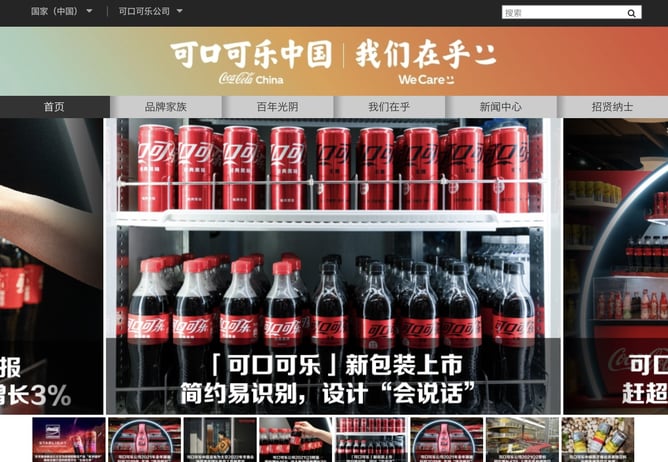A localised website is typically the first step for any international brand looking to enter the China market. But building a China optimised website will mean a lot more than a simply translation of your current website to Chinese and a ‘cn’ domain. You must adapt to the needs and preferences of Chinese digital consumers, as well as a unique digital ecosystem that is unrecognizable to many Western netizens.
China leads the world in many key digital metrics: it has the most internet users of any country and is the world’s biggest ecommerce market, worth an estimated $US1.7 trillion in 2020. Yet many foreign brands' websites don't even load within China, let alone are optimised for a digitally-sophisticated consumer.
There are several technical requirements to ensuring your site functions within the Great Firewall. However, your website content and design also deserve real attention. Spending time and effort getting both elements right is critical to not only website traffic and conversion rate, but also to how well your website works to build trust with Chinese audiences.
To help your brand succeed in this unique digital ecosystem, here are the top 5 tips on how to build a website for China:
- Design your website for the Chinese consumer.
- Optimise your website for Chinese search engines.
- Have a content-friendly website
- Feature Chinese social media platform.
- Ensure that it is mobile-responsive.
Choose website designs that appeal to Chinese audiences
While globalisation has tended to create a more homogenous looking internet, Chinese websites still tend to be busier, brighter and more complicated in design overall. Traditionally, there are a number of key differences in design that can help you understand Chinese consumer preferences. Some of these become obvious when you compare Western and Chinese websites of multinational brands.
Example of Chinese versus Western website design by a foreign brand:


When comparing, you may have noticed there are significant differences in 4 key areas:
Use of white space
Modern Western websites tend to be simple in design and use a lot of white space, whereas Chinese websites can appear much more cluttered. This is because Chinese websites maximise the web-space available. This means you will see often large chunks of information and banner advertisements that fill up the page.
Navigation layout and information categories
Western websites keep navigational items to a minimum to direct the user journey through the site as much as possible. Chinese websites often provide quite a lot of navigation options. Menus have general categories as well as shortcuts to popular specific topics. When clicked, links open in new windows or tabs; allowing users to easily compare information.
Even though both Western and Chinese websites have collapsible submenus, Chinese websites use a horizontal design. This means that content is displayed horizontally across the webpage rather than vertically down.
Colour choices and visuals
Western websites are minimalistic with the way they use colours, whereas Chinese websites use a wider colour scheme. Flash and animated content are often used. By incorporating bright colours and plenty of pictures, this will appeal to the Chinese user.
Integration of QR codes
Most Chinese websites feature a QR code on their homepage. This will help drive a seamless mobile integration. A quick scan of the QR code can give users more information about the product, promotional discounts or benefits.
Optimise website for Chinese search engines
China's Great Firewall prevents a lot of the service infrastructure available in the West from working. Instead, there are completely different services and a whole different set of Chinese search engines. In China, Baidu is the dominant player. This means that SEO in China should be focused on Baidu. If you optimise your website for Baidu, you will allow your website to be easily found by the Chinese audience.
However, the mechanisms of Baidu are quite different to Western search engines such as Google.
SEO in China should be focused on Baidu.
For example, Baidu places greater preference towards localised servers. This means websites that are hosted locally in China will have a higher search engine result. This also applies to domain names, with the domain ‘cn’ having greater authority.
Baidu places heavy emphasis on link-building. It takes into consideration both the quality and quantity of links. Therefore, it is important to build high-quality, relevant links that redirect back to your website.
Baidu, like Google, heavily preferences websites that regularly publish new content, so it's worth considering a website publishing platform (like ours!) that makes allows you to simply and cost effectively publish new content.
Have a content-friendly website
With the technicalities put aside, it is important to have website content that resonates with the Chinese audience. Simply translating your English content to Chinese will not work. Instead, it should be adapted to the local market – taking into consideration appropriate social and cultural references.
It is important to have website content that resonates with the Chinese audience.
For example, you can research key trends in China and points of interest that resonate with Chinese internet users. Try to incorporate this into your product or service offering where applicable. It is also important to ensure that your website content does not contain sensitive words or delve into a sensitive content, otherwise it will be blocked and not accessible.
Feature Chinese social media platforms
Featuring Western social media platforms such as Facebook or Instagram on your website will get you nowhere. This is because these applications are not accessible behind the Great Firewall of China. Internet users in China are not able to access them, let alone maintain an active account on these platforms.
Instead, it is important to feature links to your official Chinese social media accounts such as WeChat, Weibo, Qzone and Youku. Chinese consumers spend half their mobile use time on social apps, so a consideration of your social presence is critical. WeChat is the reigning champion of the bunch; a megaplatform that allows users not only to stay connected with friends, but also post videos and images, order a taxi, purchase movie ticets, etc. With more than one billion users, WeChat is a fundamental tool for brands looking to reach Chinese internet users.
Ensure it is mobile-responsive
Chinese people are heavy mobile users. Chinese adults spent an average of over three hours a day on their phones during 2021. Chinese people use their phones to pay for services more than any other country in the world, at more than 60% penetration.
That’s why it’s essential for international brands to build a mobile-responsive website to appeal to their Chinese target audience. This will ensure a better user experience for customers. They will be able to easily access relevant information and the fast-loading speed will keep them on your website longer.
It is essential for international brands to build a mobile-responsive website to appeal to their Chinese target audience.











